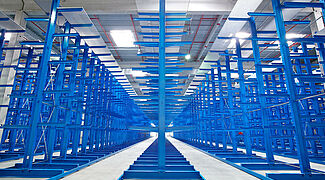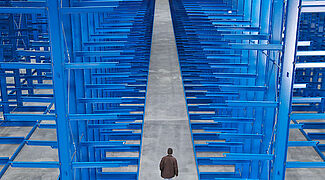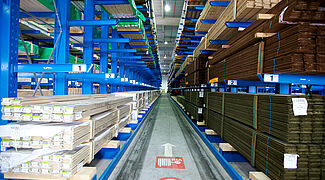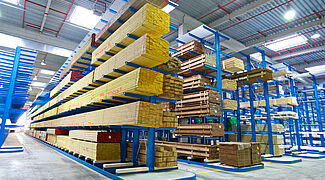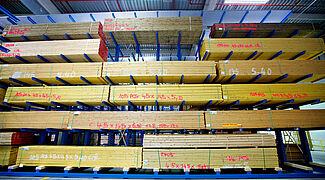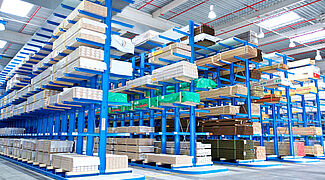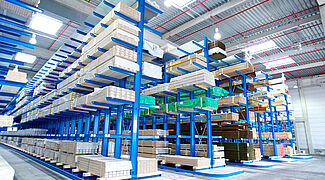Gallery
New Logistics Platform for the Building Materials Supplier DORAS
The distribution centre had become too small for the French building materials supplier DORAS: a new logistics platform with 22 aisles was needed to provide sufficient room for articles such as chipboard, laminate and other building materials. The Kerpen based company OHRA built the rack facility in a project time of just 5 months. With a storage height of 8 metres extending across 12,000m² of floor space, it is of a size rarely encountered in France or elsewhere.
As Gaston Doras bought a small builders merchants in Dijon in 1928, he didn’t suspect that 100 years later his surname would stand for the largest building materials suppliers in the eastern region of France. Today the DORAS network unites four brand names:
As building materials supplier, Doras has over 50 branches, primarily located in the Bourgogne Franche-Comté region,
Locouti manages the leasing of equipment and scaffolding,
Caréo is specialised in tiling and boarding work, parquet flooring and bathrooms,
Ménéo covers the supply and execution of carpentry work (windows, doors, stairs, portals
The DORAS network now employs around 800 employees and in 2010 generated a turnover of 208 million Euros.
Inefficient and too small
Up until April 2011 both customers and the various distribution centres for wood products were supplied with goods from one platform located on the site of the company headquarters in Chenôve. However, following the rapid growth enjoyed by DORAS in recent years this platform reached the limits of its capacity. Housed in an old building with low-ceilinged storage rooms and poor floor plan and equipped with outmoded storage equipment the building was hardly capable of meeting the company’s modern needs.
“The old warehouse was no longer able to keep up with the development of our company”, recalls Brigitte Biju-Duval, DORAS director responsible for investment. “There was insufficient storage capacity, the travel routes were congested due to the increased volume of goods and the cramped loading areas proved to be a hindrance.”
Generously dimensioned
DORAS decided to move into a new warehouse. With 12,000 m² of floor space the rented building offered significantly more space than the old warehouse. The new logistics facilities had the advantage of providing more room for the wooden building materials business, with additional space provided for wood products such as chipboard, plywood or parquet flooring.
According to the plans of the technical department of the building materials supplier the new project would consist, on the one side, of a cantilever rack facility with 15 rows, each 75m in length and 8m high for the storage of long goods up to 13m in length, and on the other side, a further 10 rows with 8.5m high pallet racks also 75m in length. A total of 22 aisles were planned, of which 12 were to be realised as narrow aisle cantilever racks. Multiway forklifts were selected for the purpose of storage and stock removal.
Big enough for large scale projects
DORAS commissioned OHRA Regalanlagen GmbH, based in Kerpen near Cologne, to install the racks: The company was a specialist for the construction of warehouse and rack systems, above all for building material and metal suppliers as well as the timber industry. During the planning of this warehousing project the DORAS team came to value the know how of OHRA’s French sales representatives who were able to draw on their experiences from similar large-scale projects.
According to Brigitte Biju-Duval “A decisive factor in the choice of OHRA was the scale of our project”. “We had to exclude certain competitors who were unable to meet our requirements for a load reduction of 10.5 t. In addition, the supplier also had to prove that they could manage the project economically, that is shoulder the advance costs specified in the contract document.”
However the rack solution from OHRA also convinced in terms of the details: For example, the Kerpen based company exclusively uses solid-walled, hot-rolled standard structural steel for the cantilever racks – in contrast to sheet metal the material retains its statical properties even under rough warehouse conditions. During the handling of the warehouse stock during storage or stock removal contact with the arms can lead to damage to the goods, especially when handling wooden beams with excess length. In order to protect the stock OHRA employs self-protecting insertable arms – in the event of impacts they move upwards and to the side. Stock and rack remain undamaged.
Assembly in nine weeks
At the beginning of December 2010 OHRA received the order to supply and install the rack facility for DORAS’ new distribution centre. “Cantilever racks with rows 75 meters long and 8 meters high together with a guide rail demand enormous precision during assembly” is how Bernard Lunven, OHRA’s sales manager for France, described the special challenge for the OHRA fitters. They arrived at the building site in the middle of March 2011, together with the first 23 HGVs with material. In the following nine weeks they assembled 750 cantilever rack supports, 8,000 arms – in some cases with gratings – as well as 2 kilometres of guide rail for the 4-way forklift. The guide rails in the entrance area were grouted with concrete in order to strengthen them and improve the reliability of the passage of the forklift into the aisles. The OHRA 5 Omega system has been deployed in the pallet warehousing area. It is capable of supporting field loads of up to 22.5 t and individual component loads of up to 4.5 t. Overall the OHRA fitters built a total of 1,500 pallet spaces, with individual levels fitted with gratings. The order also included a steel platform with an area of 55 m². The work was completed by the end of April.
“The time plan was adhered to”, said Brigitte Biju-Duval in praise of OHRA’s performance. “Thanks to their expertise we received optimal support from OHRA from the project development at DORAS through to the subsequent completion.” Ultimately, OHRA proved that quality “Made in Germany”, despite a greater use of materials and a high quality rack system, was able to win out against lighter competitor systems in terms of price/performance ratio.

